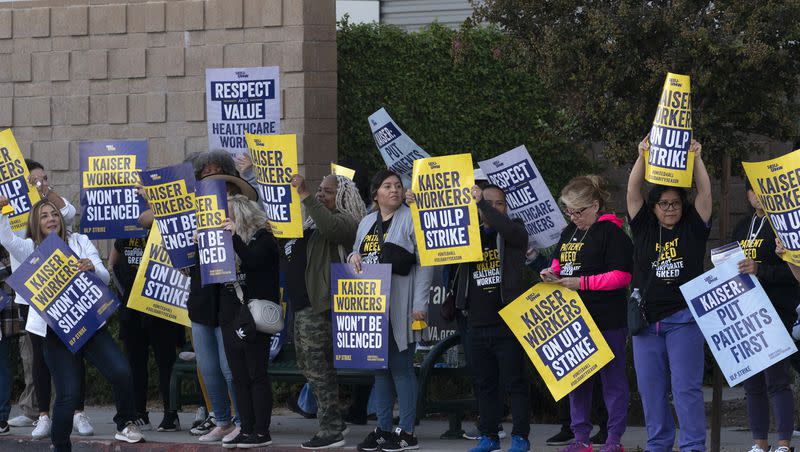Strike begins as 75,000 health care workers walk out

Picket lines went up early Wednesday as the nation’s largest-ever health care worker strike began. An estimated 75,000 Kaiser Permanente staffers walked out when contract negotiations stalled.
The strike is slated to end Saturday morning.
Staffing levels are at the heart of the dispute as workers note burnout, CNBC reported. And raises have proven to be a sticking point as well.
The protest involves employees at hospitals and medical offices in California, Colorado, Oregon, Virginia, Washington state and Washington, D.C. Those manning the picket lines include nursing staff, nutrition workers, receptionists, optometrists, pharmacists, vocational nurses, X-ray technicians, respiratory therapists, emergency department technicians and others — all represented by eight different unions operating for the purpose of negotiations and the strike as “the Coalition of Kaiser Permanente Unions.”
About 400 pharmacists and optometrists in Virginia and Washington, D.C., are planning a one-day strike, per The Washington Post.
Per CNBC, the health care system serves 13 million patients and runs 39 hospitals and more than 600 medical officers nationwide.
CNN reported the workers represented by the coalition make up 40% of the staff at Kaiser Permanente, which is among the largest health care nonprofits in the United States.
While the bulk of the strike is planned to last three days, with workers returning to work at 6 a.m. in each community on Oct. 7, the largest union in the negotiations, SEIU-UHW, said a “longer, stronger strike” might be called in November if no contract agreement is reached. It did acknowledge progress, but said employee raises have been a sticking point. The union coalition wants raises that at least keep up with cost-of-living increases.
Kaiser Permanente services are provided to “members” who pay dues. And doctors and most nurses are not striking. But the company has warned ahead of the strike that elective and nonemergency services may be rescheduled out of what it calls “an abundance of caution.”
Still, the company said that all of its hospitals and emergency departments will remain open during the strike.
What the unions want
Per CNN, “The unprecedented strike comes at a time of heightened labor activity across the United States, with tens of thousands of workers across multiple industries taking to the picket lines for better pay and benefits. In the wake of the pandemic, however, health care workers in particular have been fighting for safer and more secure work environments. They are demanding improved staffing levels, arguing that current staff shortages are compromising patient care and taking many workers to a breaking point.”
Conditions aren’t safe for workers, according to Caroline Lucas, executive director of the Coalition of Kaiser Permanente Unions. “We continue to have front-line health care workers who are burnt out and stretched to the max and leaving the industry,” Lucas told CNBC. “We have folks getting injured on the job because they’re trying to do too much and see too many people and work too quickly. It’s not a sustainable situation,” she said.
“I don’t want to strike,” Amanda Curling, 42, an optometrist at Tysons Corner Medical Center who spoke of crisis-level staffing shortages, told The Washington Post. “I just want to take care of my patients. I really want the Kaiser executives to listen to us … and invest in us.”
“This is the first time I’ve seen multiple pages of open jobs that aren’t being filled. This isn’t about Kaiser being the devil. I’d like to see Kaiser move back to being beyond amazing. It used to be the promised land for nurses,” striking emergency room nurse Justin Seronko of Moreno Valley, California, told The Washington Post.
In response to staffing shortages, Kaiser Permanente has promised robust hiring, done quickly. Other issues include better pay, developing a strategy to manage staff shortages, an end to outsourcing that jeopardizes the jobs of those already hired and more notice before calling remote workers back to on-site work.
Some have been addressed. Kaiser Permanente, for instance, said remote workers will be given 60 days’ notice to return to work. And the company also agreed to protections for outsourcing and subcontracting.
No agreement has been reached on pay raises yet.
“Workers are really being squeezed right now,” Renee Saldana, a spokesperson for SEIU-UHW, told CNN. “They went through the worst global health crisis in a generation and then they come out and they’re worried about paying rent, they’re worried about losing their house, they’re worried about living in their cars.”
The health care system counters that it is an industry leader when it comes to pay in its markets.
According to The Associated Press, “Kaiser executive Michelle Gaskill-Hames defended the company and said its practices, compensation and retention are better than its competitors, even as the entire sector faces the same challenges.”
“Our focus, for the dollars that we bring in, are to keep them invested in value-based care,” said Gaskill-Hames, president of Kaiser Foundation Health Plan and Hospitals of Southern California and Hawaii, told AP.
Reuters wrote that “Kaiser has reported profits of $3 billion in the first half of 2023 and over $24 billion over the last five years. As a nonprofit organization, it pays no income tax on its earnings and very limited property taxes.”
The article notes that numerous fields have seen strikes over pay and benefits in 2023, including auto workers and Hollywood writers and actors. “Nearly 309,700 workers have been involved in work stoppages through August this year, according to U.S. Bureau of Labor Statistics data, putting 2023 on track to become the busiest year for strikes since 2019,” per Reuters.

